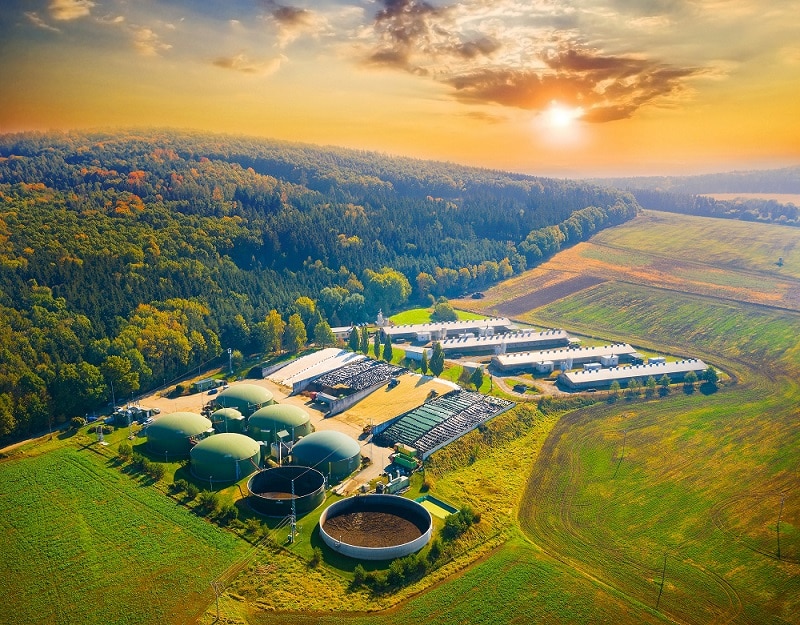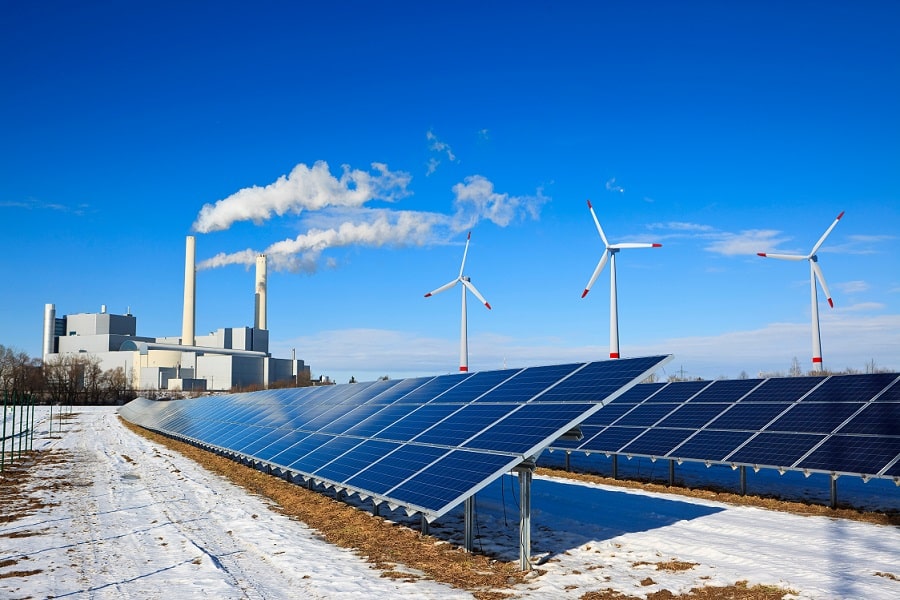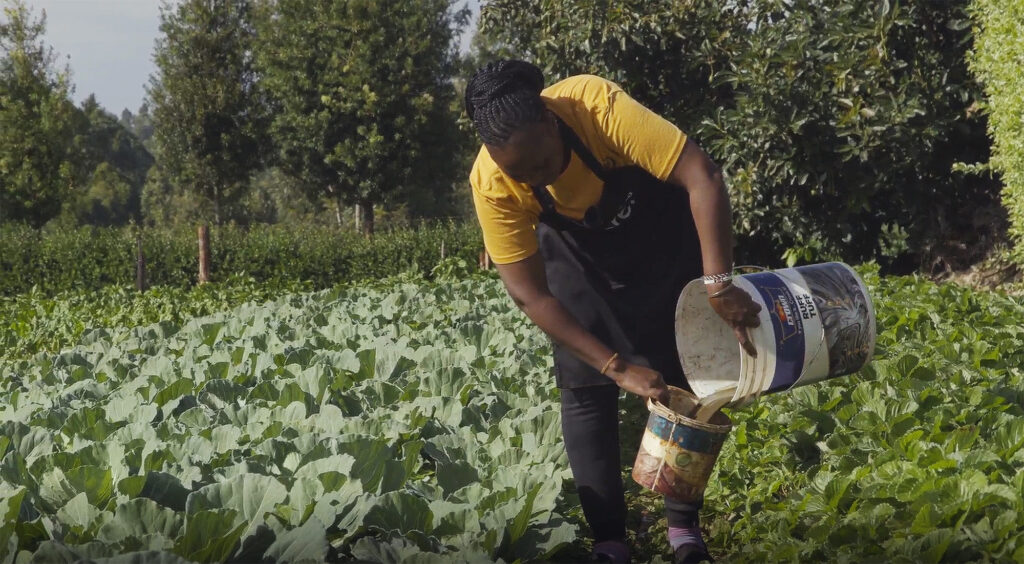
What is Biomethane?
Biomethane is methane coming from biomass. Its characteristics make it similar to natural gas, meaning it can be transported and stored using existing infrastructure but with a lower environmental impact.
The biomethane production process prevents the emission of significant amounts of methane and other hazardous gases into the atmosphere, reducing the amounts of organic matter that decomposes in fields. Moreover, since less fossil fuel is needed when using biomethane, the parts of greenhouse gas released into the atmosphere will also be lower.
Terminology explained
Biogas, biomethane, green gas, renewable gas, and sometimes biofuel are often used as synonyms, even if they don’t always have the same meaning. Biogas, for example, is used to produce biomethane. Then, the terms biomethane, green gas, and renewable gas can all refer to the same substance — methane created through organic matter decomposition.
It’s important to mention that, although biomethane is labeled as renewable gas, there are other types of renewable gases (such as hydrogen), so some terms might be more generic than others and aren’t always interchangeable. The same is true for the term biofuel.
What is Biomethane Made of?
Biomethane is usually obtained by treating biogas through an “upgrading” process that eliminates carbon dioxide and other residues. Another method for creating biomethane is gasifying solid biomass, followed by methanation.
1. Biogas to biomethane conversion
Biogas comes from decomposed biomass through anaerobic digestion and is rich in methane and carbon dioxide. The product also contains traces of water vapor, hydrogen sulfide, siloxanes, hydrocarbons, ammonia, oxygen, carbon monoxide, and nitrogen.
Converting biogas to biomethane requires a cleaning process that eliminates most trace components to obtain a near-pure source of methane. After this first step, biomethane must undergo an upgrading process that changes its calorific value. This step brings the substance as close as possible to natural gas so it can be used as a green alternative to fossil fuel.
The upgrading process can require different techniques, depending on what substances must be removed and the gas quality requirements. The end product must have more than 95% methane content to reach the same properties as natural gas.
2. Thermal gasification of solid biomass, followed by methanation
Bacteria break down solid biomass in an atmosphere with low oxygen, high pressure, and high temperature, resulting in a mixture of gases, primarily carbon monoxide, hydrogen, and methane.
This mixture of gases is then cleaned to remove any corrosive components to generate a pure stream of biomethane.
After this first step, the product is ready for methanation — a catalyst accelerates the reaction between the hydrogen and carbon monoxide to obtain methane. The process is completed when all carbon dioxide and water residues are eliminated.
Biomethane from Upgrading Biogas – Major Source for Future Growth
Most biomethane used today comes from upgrading biogas, a reliable energy source and an eco-friendly alternative to fossil fuels. The process is highly effective for domestic usage and small communities, but scaling comes with challenges. Once they’re solved, biomethane can cover more energy demand with a positive environmental impact.
For now, biogas upgrading comes with a series of issues, such as unstable production of high-purity methane gas, a need for sizeable production facilities, and significant energy consumption throughout the upgrading process.
Upgrading techniques usually use pressure swing adsorption, membrane separation, or water or amine as an absorbent, each with specific equipment required. All these methods are easy to operate and maintain, but they need a lot of energy, quickly becoming a problem when trying to keep expenses within a reasonable range. Production facilities in The US, China, India, and some EU countries have benefited from government support to maintain operations with encouraging results.
The advantage of biogas facilities is their flexibility compared to wind and solar PV systems. However, with a limited number of facilities running worldwide, it’s still too soon to understand how effective biogas upgrading is at scale.
Acknowledging the value of these services can boost the potential for future biogas plant deployment.
The EU, for example, estimates that significant scaling up is possible with biomethane. The target is an annual production of enough biomethane to cover almost 10% of the expected natural gas consumption by 2030. According to European experts, this amount of biomethane would prevent 110 Mtonnes of carbon dioxide equivalent emissions.
Benefits of Biomethane
- Biomethane is a sustainable energy source, as the organic material required to make biomethane is abundant across all geographical zones. Biomethane can be obtained from sequential crops, woody by-products, animal by-products, plant by-products, household bio waste, and industrial and municipal organic waste.
- It supports energy independence. Biomethane reduces vulnerability to disruptions in the global energy supply market, as raw materials necessary to produce it are accessible to most countries internally. Moreover, the supply isn’t weather-dependent, an issue alternative energy sources like solar energy and wind power have to counter.
- Biomethane usage reduces greenhouse gas emissions by substituting fossil fuels. Studies showed that biomethane production could reduce greenhouse gas emissions by up to 240% and biomethane emissions by up to 202% compared to fossil fuels used in the EU. Moreover, biomethane ensures a significant improvement in air quality, especially in urban contexts, thanks to the almost absence of particulates and nitrogen monoxide.
- Biomethane doesn’t disrupt nature. In contrast to mining, natural gas extraction, or even some renewable sources, biomethane production facilities only minimally disturb the environment.
- It’s easy to implement because it doesn’t require additional infrastructure or equipment. Biomethane is the same as natural gas, so storage and transportation can use almost all existing infrastructure with minimum long-term side effects.
- Biomethane has reasonable production costs. The primary raw material used to make biomethane is organic waste, a free resource. Plus, the technology needed to extract biomethane from degrading organic matter is neither edge-cutting nor expensive.
Biomethane: “Green” Value for the Planet
Biomethane is an economical and potentially scalable renewable natural gas, making it a valuable ally for governments and small communities aiming to reduce their carbon footprint.
Its versatility makes it a viable alternative to fossil fuels, with excellent results across industries and verticals:
- Hybrid heat pumps can decarbonize buildings using biomethane instead of natural gas.
- For industrial processes, biomethane can generate high-temperature heat while generating climate-neutral carbon.
- The marine and aviation sectors can shift to alternative fuels to reduce greenhouse gas emissions.
- Biomethane fuel can revolutionize long-distance road transportation to reduce environmental impact.
Biomethane’s green value for the planet is conditional upon not producing extra raw materials specifically for biomethane production and negatively impacting the environment.
Combining biomethane and natural gas technologies can help meet global goals of clean air and climate change. However, biomethane can currently cover less than 3% of the overall bioenergy demand. Even if biofuels and alternative fuel sources establish themselves more firmly in the future, biomethane alone can’t completely substitute fossil fuels, so multiple renewable energy sources are necessary to maintain the positive effects in the long run.
Is Biomethane Climate-Friendly?
Biomethane is climate-friendly because it has a low influence on global warming.
On the one hand, it keeps tons of waste away from landfills, significantly impacting methane emissions and water and soil quality. Methane traps heat in the atmosphere 25 times more effectively than carbon dioxide. Since it’s a potent greenhouse gas with a shorter lifetime than carbon dioxide, reducing the amounts of gas released in the atmosphere would quickly and significantly reduce atmospheric warming.
On the other hand, methane can replace fossil fuels. Studies have shown that replacing traditional energy sources with biomethane in domestic use can significantly influence how communities manage climate change mitigation.

The Role of Biomethane in the Transformation of the Energy System
Biomethane has the potential to maintain stability within the energy system and smooth transition from traditional, highly-polluting energy sources to green energy.
Production facilities can function all year long to maintain a steady supply of biogas and biomethane. That’s because manure and organic waste from food processing keep building up. Moreover, harvested biomass can be stored in silos to ensure biogas energy can be produced every season.
While these facilities can’t produce enough biomethane to cover all our energy needs, they can compensate for the inconsistent electricity generation from alternative renewable energy sources like wind and solar photovoltaic systems. This way, balance and regular delivery can be reached with no need for fossil fuels while reducing the need to import energy.
This benefit becomes more substantial when we consider the biomethane gas’s capacity to be directly injected into the current natural gas system and used anywhere, regardless of the facility’s location.
Biomethane: Global Market Development
Market predictions for biogas and biomethane confirm that there’s room for growth and scalability. In 2020, the global biomethane market was valued at $1.9 billion, and the compound annual growth rate is expected to stay on average at 6.9% between 2021 and 2031.
What can drive growth in the industry? The power generation industry and the need for alternative fuels in transportation are rising. On the other hand, growing worries about fossil fuels make it difficult to rely exclusively on traditional energy sources, making it likely for the biomethane market to see potential growth.
Biomethane is becoming more and more popular as people become more aware of clean, environmentally friendly fuel options. If researchers and market participants work together to meet consumer demand for biomethane, we can expect more steps toward expanding biogas and biomethane production.
Conclusions
Biomethane and biofuels can support the transition to green energy sources by working as a stabilizer in the energy system.
The rise in demand for green and clean fuels creates the perfect environment for the biomethane market to grow with minimum impact on climate change. Thanks to its natural production process, biomethane is an eco-friendly, reliable energy source to complement alternative energy sources for increased efficiency across industries.






